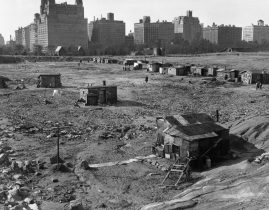
One of the most pressing issues during the Depression was the thousands of people who faced the struggle of finding shelter after being evicted from their homes and being forced out onto the streets. Many New Yorkers took to living in make-shift huts and homes located in parks or in alleyways. Large settlements of these make-shift homes often became referred to as a “Hooverville,” based on the idea that President Hoover’s lack of action toward sheltering the people forced them to make up these little settlements on their own and therefore the fault for their existence was his.[1] The largest Hooverville settlement was located in the heart of Central Park, near the Croton Reservoir. In an article titled Shantytown, U.S.A., two men named Delehanty and Bill lead a reporter named Boris Isreal around the Hooverville next to the Croton Reservoir explaining to him the dynamics of the settlement. Delehanty explains that many of the men who lived in the Hooverville were trade-workers. It became common for these trade-workers, such as masons, engineers and architects to construct elaborate brick or wooden shacks within their settlements. Bill explains that “there are three hundred to three hundred forty men who have built themselves homes in this one Hooverville,” and that “men who can build houses like this from salvaged materials are the men who built the buildings now standing empty in all those cities.”[2] Despite being popular places for the indigent to settle, Hoovervilles were illegal settlements and forces from the local and federal government often raided Hoovervilles, destroying shelters and scaring the people out of the settlements to ward off crime. Despite the fact that their “homes” were illegal, many New Yorkers felt that Hoovervilles were the “foundation of our nation” during the depression.[3]
[1] Israel, Boris. “Shantytown, U. S. A.” New Republic 75.964 (1933): 39. Points of View Reference Center. Web. 6 Oct. 2016.
[2] Ibid, 40
[3] Ibid, 41
Here it is 7 years later, with NYC facing the problem of insufficient housing for arriving immigrants, and discussions arising about housing them in Hooverville like tents in Central Park, an idea which is pretty much unimaginable to me. How the world turns!